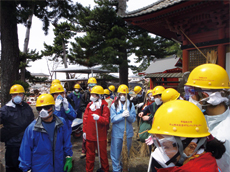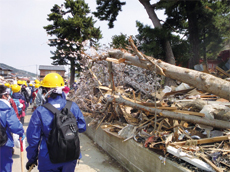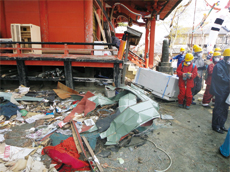 Go
Go
Onsite Report
Earthquake volunteers activities held by the Hirayama Ikuo Volunteer Center (2nd group deployed to Ishinomaki City, Miyagi Prefecture)
Yu Takahashi
2nd year student, School of Social Sciences

Receiving an explanation before starting work

Passing by a fallen cherry tree blooming within the shrine grounds

Cleaning the shrine grounds in order to hold a festival
From late-night on April 25th until the 26th, I participated in a volunteer project held in Ishinomaki City, Miyagi Prefecture. Ishinomaki City suffered catastrophic damage during the Great East Japan Earthquake.
I decided to participate because a friend of mine studying at the same undergraduate school was a victim of the earthquake in Ibaraki Prefecture. My friend was left without running water or gas. More than ever before, I felt that earthquakes are an issue that is close to home. My friend is affiliated with WAVOC and I received information on this project. We were limited to 1 day of onsite volunteer activities, and I was worried that I wouldn't be able to help in such a short period of time. However, I decided to participate to raise my own level of consciousness.
We conducted volunteer activities at a shrine in the Watanoha Town of Ishinomaki City. We were requested to clear debris and clean the shrine because a festival was to be held on May 5th. A total of 52 volunteers participated in the activities. All participants were fully equipped with anti-dust masks, protective goggles, long rubber boots and rain jackets. However, the work proved to be very difficult. Wet tatami mats were far heavier than we thought, and it took 5 or 6 of us to carry a mat. Moreover, we had to use a handsaw to cut collapsed sections of roofing. Some volunteers had their rain jackets torn by nails when clearing away wooden debris. An awful smell came from rotting fish which had been washed ashore. Despite wearing masks, the intrusion of dust had volunteers coughing immediately. Still, through cooperation between individual teams and cooperation with volunteers able to use heavy equipment, we were able to clear space for the festival by lunchtime.
In the afternoon, the chief priest of the shrine invited local people who were kind enough to speak with us. The locals described how water from the tsunami came to the floor of the shrine, which is located on relatively high ground for this neighborhood. They discussed how the estimated 10 meter tsunami from the 1960 Great Chilean Earthquake did not result in severe damage and how experiences from that earthquake led to the estimation that the recent Tohoku earthquake would not cause great damage. They also related how many people who had gathered together were swallowed by the tsunami, even discussing how they actually carried bodies of the deceased. While listening to their stories, I felt the tragedy and pain of the earthquake, and I strongly realized that such stories must be conveyed to even more people.
The recent volunteer work was simply to help clear debris from around the shrine, placing the debris on the road so that it could be carried away by trucks of the Japanese Self Defense Force. Upon seeing the large amounts of remaining debris and being unable to help clean up the many private homes, it was difficult to return to the university. However, I found solace in the words of the chief priest. "Help the person next to you. If you do so, that person will immediately help the person next to him." Thanks to this message, I feel that I have found ways to help even while living in Tokyo. Specifically, it is important to discuss how to respond to earthquakes with family, friends from university and coworkers. The words of the chief priest touched my heart, and I have decided to follow in his words together with the people around me. Instead of simply providing aid, I believe that such a spirit will help volunteers to considering the feelings of people who receive aid.
At the shrine, a single cherry tree produced full blossoms despite being toppled by the tsunami. On my way back to the university, I prayed that I will be able to see those same flowers on May 5th of next year.
(May 12th, 2011)
